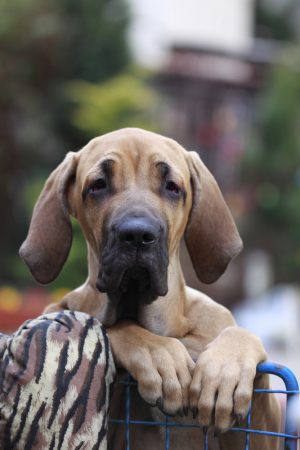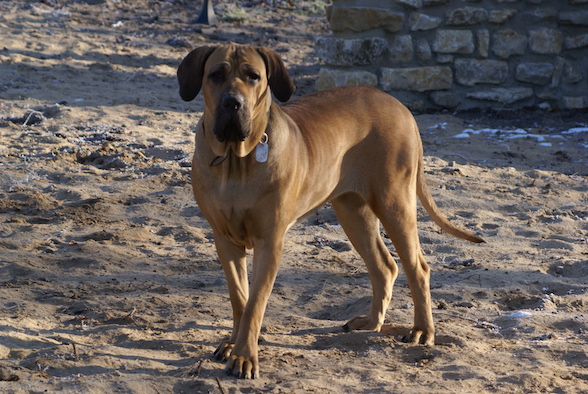
If it were any other breed save the Chesapeake Bay Retriever,* the Fila Brasileiro‘s topline could be seen as a fault. In imaginatively colorful terms, if one were to put a marble on the dog’s rump, there is enough “downhill” for it to gently roll toward the head.

Fila by Jacekjarz is licensed under CC BY-SA 3.0
This is not only not a fault, it’s called for in the FCI breed standard: “Topline: Withers, in sloping line, are set well apart from each other due to the distance between the shoulder blades. Withers are set lower than the croup.”
The “how” of it is due to the Fila’s hind legs being lighter in bone, longer, and less angulated than his front legs, and this combination gives the Fila topline its downhill appearance. The rear legs should not be straight in the stifles but should maintain a moderate angulation to achieve this. Furthermore, the croup, which has a long, sloping at angle of approximately 30 degrees to the horizontal ending in a smooth curve, is set a little higher than the withers. This structure accounts for the Fila’s distinctive gait.
The “why” it is simple: The Fila is a big dog, and this conformation enables a Fila to be extremely – and deceptively – agile for its size. Their appearance may seen lazy, even clumsy, but in action, the Fila is nimble and capable of sudden and swift changes in direction, something a Fila needed when moving skittish semi-wild cattle. There was a time when butchers in Brazil kept slaughterhouses near their homes, the sources of meat for local towns. Açougueiros would ride horseback through their area buying a cow here and there, but these animals were often the most dangerous cattle, and just one could jeopardize an entire herd by breaking through a fence. Herding groups of such cattle was an almost impossible task without the help of an efficient cattle dog like the Fila.
Filas were also used to hunt oncas-pintadas, or Brazilian jaguars, which were a serious threat to cattle in many regions of Brazil. In what is another example of form following function, the body of a Fila should be covered by a thick, elastic, loose skin, and indeed, during breed judging at a dog show, a judge should ask the handler to lift the skin beginning at the withers, mid-back, and above the croup. This loose skin is critical to the breed because it saved the lives of many dogs at the receiving end of a Jaguar’s swipe of a powerful paw. Instead of severing a jugular vein or damaging the dog’s muscle, the big cat got a paw full of skin.
Handling livestock and hunting jaguars were so much the breed’s primary jobs that early on, the breed was known in central Brazil only by names connected to its functions: Onceiro and Boiadeiro, i.e. “a dog that is used for hunting jaguars and handling bulls.”
When the first written standard for the Fila (the only native Brazilian dog breed) was published in 1946, the responsibility of dealing with breed registrations, as well as planning and executing breeding programs was given to the Paulistas, the residents of the Brazilian state of São Paulo. Today, the Brazilian Confederation Kennel Club looks after all the registries as members of the Federation Cynologique Internationale (FCI).
*The Chesapeake Bay Retriever AKC breed standard reads, “Topline should show the hindquarters to be as high as or a trifle higher than the shoulders.”
Image: Fila puppy by ©Lukas Blazek/Dreamstime.com

Please do not send this site to me. Once a month would have been interesting, once a day a bloody nuisance.
Raylee, apologies, but we are unable to unsubscribe you from the alerts you signed up to receive, you have to do it yourself. Simply go to the website and click on the little bell icon in the bottom right hand corner. You’ll get directions from there.